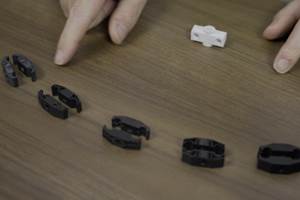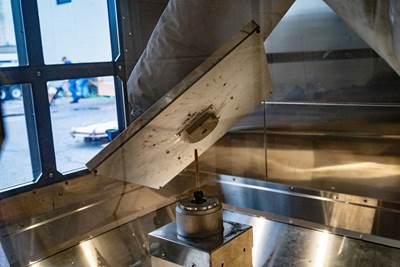What is the application for directed energy deposition? What is DED’s role? The answer is changing. In fact, it has changed so much, it may now be time to revise our understanding of the place and possibilities of this AM process.
For a long time, the short answer to the question “What is DED for?” would generally have been “repair.” When it comes to making a complete metal part from scratch, moving a laser through a bed of powder (à la laser powder bed fusion) is often more efficient than moving the flow of powder and the laser together in DED. But when it comes to repairing an existing component like a tool or a turbine blade, the ability to target metal placement is invaluable. No one at any time would have claimed repair was DED’s only use, but repair has long been a distinctive strength. Now, two important developments have served to advance DED’s role.
First, the range of practical options in DED have expanded. Alongside blown-powder systems, wire-fed systems are now at least as accessible if not more so. The latter systems provide faster deposition rate, allowing complete metal parts and big metal parts to be made more quickly and cheaply than previously. They also improve ease of use, as spools of wire make material handling easy. Add to this the arrival of cold-spray AM systems performing metal deposition without the difficulty of a liquid-to-solid transition. This type of metal 3D printing is DED as well, just with the “directed energy” applied to propulsion rather than melting.
Then, the second development, which has proceeded at about the same pace as the first, is an increased questioning of casting. Additive cannot compete with the speed and economy of casting at its best, but foundry capacity is limited, and like every limited resource, that capacity gets allocated. Production parts at the production volumes most natural to casting continue to be made this way, but as this work fills foundry schedules, the work that is at all marginal or suboptimal for casting gets scheduled out farther. Replacement parts and lower-quantity production fit this description. The same phenomenon applies to forging capacity as well. For the chance to get free of this kind of supply constraint, and also get free of the need to maintain tooling for a part that might see a long service life, OEMs and part buyers increasingly are taking a second look at AM and valuing it differently. Thus, as DED becomes more capable for making parts, the constraints on established part-making are giving it more to do.

This image and landscape image courtesy of Army Corps of Engineers. Read more on this DED application.
Some sense of how much this is all coming to mean can be found in various pieces we have posted recently — various stories offering different pictures of DED in action, whether blown-powder, wire-fed or cold-spray systems. The applications include adding features, including a simple feature for a production part, or much more elaborate features added to a part that, as it happens, starts out being made through powder bed fusion. The applications also include DED being used to make complete parts, and there are a variety of these. They range from a replacement part within a unique system to low-volume substitutes for castings to production hardware for which DED is the qualified process able to stand fully in forging or casting’s place. And then DED still excels for repair. As a complement to repairing turbine blades, consider repair of a massive turbine shaft.
What does DED do? Not everything. And some sense of this can be found in our coverage as well. Powder bed fusion is needed for precise forms with inner complexity; it is needed for precision parts in the most demanding metals. Every AM process is still advancing — it is the nature of a new and still-young category of manufacturing that this is so.
But the processes are prone to advance at different rates, and this is what produces category lines being redrawn. What does DED do? It adds features, makes repairs and produces runs of production parts. Those uses were always there as possibilities, but now we know DED to be suited to them all, which is maybe more than we had come to expect. For any additive process we think we “know,” for any in which the application seems to have been decided, we should stay tuned. All these technologies are still moving and changing, and none of the final words have been written.
Related Content
BPMI Chooses Velo3D Metal 3D Printing System to Produce Parts for U.S. Naval Nuclear Propulsion Program
The fully integrated 3D printing solution will be operated by ATI in a newly established facility that will provide the U.S. Naval Nuclear Propulsion Program with alternatives to cast parts.
Read MoreIs Every 3D Printed Replacement Part Inherently an Upgrade? AM Radio #32
Additive manufacturing is a powerful tool for replacement parts, but turning to AM offers opportunities beyond recreating what came before. In this episode of the AM Radio podcast, we discuss AM for repair, replacement and upgrades.
Read MoreNikon Lasermeister Metal DED 3D Printer and Scanner Developed for Industrial Applications, Turbine Blade Repair
This technology gives manufacturers the ability to build onto existing parts with high precision and utilize a variety of materials, reducing lead times and minimizing postprocessing requirements.
Read MoreHybrid Additive Manufacturing Machine Tools Continue to Make Gains (Includes Video)
The hybrid machine tool is an idea that continues to advance. Two important developments of recent years expand the possibilities for this platform.
Read MoreRead Next
The Cold Spray Solution to the Casting, Forging Supply Chains
Startup HAMR Industries performs additive manufacturing work at Neighborhood 91 that provides an alternative to traditional casting and forging. Success so far has led to redefining the limits of its additive equipment.
Read MoreBig Metal Additive: The Difference Between a Shape and a Part Is Quality
Preparing to scale directed energy deposition to ongoing full production is not a technological challenge: DED is ready. But it is an organizational challenge, says the company founder. Here is what it means to implement a quality system.
Read MoreMachine Tool Drawbar Made With Additive Manufacturing Saves DMG MORI 90% Lead Time and 67% CO2 Emission
A new production process for the multimetal drawbar replaces an outsourced plating step with directed energy deposition, performing this DED along with roughing, finishing and grinding on a single machine.
Read More






















